Film Society of Lincoln Center's inaugural film series Art of the Real - a showcase for nonfiction films that pushes the farthest boundaries of documentary filmmaking, is for me, one of the most exciting film series I have had the privilege to be part of, even by New York standards.
It's only been the last couple of years that I've been writing about film seriously, realizing that the medium can go much further than just mere entertainment and that freeing from the dominant narrative structure can be exhilarating.
What started out as a simple question that if there was an adequate name to describe the current crop of shape-shifting postmodern cinema pulled me into the very depth of the cinematic rabbit hole, left me exhausted and confused and exhilarated at the same time. As I was reminded watching
Film Socialisme (Godard),
Sans Soleil (Marker),
Fontainhas Trilogy (Costa),
Koker Trilogy (Kiarostami),
Tren de Sombras (Guerín),
Tabu (Gomes),
A Man Vanishes (Imamura), and
Two Years at Sea (Rivers) that I am just scratching the surface of this great artistic medium. At the same time, I feel glad and relieved that there is so much more to explore.
It was Lucien Castraing-Taylor and Verena Paravel's
Leviathan screening at New York Film Festival in 2012 where everything clicked for me. Watching the film I noticed French filmmaker Philippe Grandrieux, whose visceral art films happen to be some of my very favorite film watching experiences, sitting in the audience. Castraing-Taylor and Paravel turned out to be good friends of Grandrieux. And the subsequent discussion I had with Castraing-Taylor and Paravel (my interview
here) reaffirmed for me that there could be much more to film as an art form than a mere telling of story with moving pictures.
Curated by Dennis Lim and Racheal Rakes, and presented in collaboration with the 2014 Whitney Biennial, along with the focus on the Sensory Ethnography Lab, I have no doubt Art of the Real's enthralling lineup will delight serious, adventurous film lovers' senses and help expand their minds.
The series include last year's festival favorite
Manakamana (read Kurt's review from TIFF
here), works by renowned experimental filmmakers/documentarians - Thom Andersen, Harun Farocki, Robert Gardener, Alain Cavalier, Raymond Depardon, James Benning and more.
The series runs April 11 - 26. For tickets and more information, please visit
Film Society of Lincoln Center website.
Read on for some personal highlights from the series (with an assist by Ben Umstead)
Benjamin Umstead
contributed to this story.
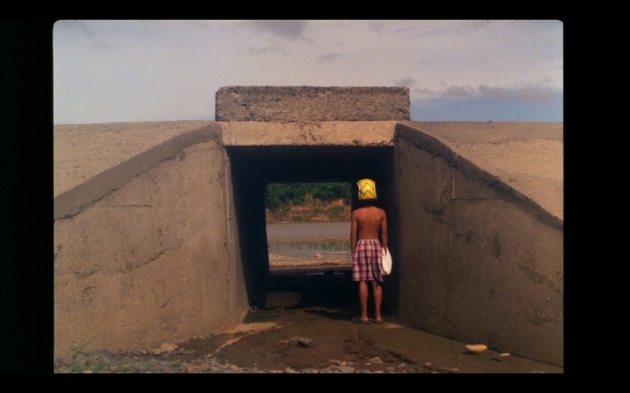
LUKAS THE STRANGE - John Torres
A girl narrator, the friend of a 13-year old Filipino boy named Lukas, whispers to him softly and gives a loose, elliptical narrative to this all together dreamlike, strange film. The narrator tells him that it's the beginning of the film and he doesn't know it yet, but he will fall in love with an actress later in the film. One night, Lukas is told that his father is tikbalang (half-man, half-horse). In turn, his father abandons his family and disappears across the river. There is a film crew in town, casting roles and everyone in town is in a buzz. So goes Lukas the Strange - part documentary, part narrative, part free-association visual essay, part...
Lukas thinks he inherited some super powers and needs to test his abilities. He can run fast, he can jump high. He is bullet proof and has scars to prove it. Meanwhile, his father has settled in a neighboring town. He earned a scar when he crossed the river but left his memories behind. The river has magical powers like that. There are videotapes that the narrator girl collected from the river. It contains grainly black and white footage of the actress the narrator talked about in the beginning. Lukas watches and falls in love (at least he tries to masturbate to it).
Shot on 35mm in full frame format, the rural Philippines in rainy season has never been more beautiful. The faces of none actors with out of synch sound (or just made up sound to push along the narrative) gives the film its light, playful tone. This is perhaps the dreamiest, strangest film about a boy entering manhood. Folklore, improvisation, formal rigor...this is good stuff, very much akin to Weerasethakul films.

ACTRESS - Robert Greene
Brandy Burre was an actress who was on The Wire. She gave up acting to have a family, and moved to Beacon, NY with her partner, Tim. They have two young children. They own two restaurants/bars. But now in her late 30s, she realizes that being a housewife/mom of two kids is not what she wanted. She wants to get back into the business. Director Robert Greene chronicles trials and tribulations of an actress as she struggles with her life. Brandy's story is nothing really special. A lot of people go through the same family vs career crises. She has an affair, Tim moves out, she looks for a job, battling ageism and stage fright. It couldn't be any more special than a Lifetime channel movie. But that's just it. Because she is a real person, not an actress, it is quite compelling.
There is a scene where Burre putting away toys in the 'toy room', labeling them carefully with label maker. She says, "This is how I express my creativity." Then she says it again, as if reciting a line from a script. It's meta-ness aside, Actress, thanks to Burre's brevity to reveal her life in such a frank way and Greene's intimate approach, is quite mesmerizing experience. I had to IMDb Burre as she had only one more film under her name after The Wire. Good to know that she is working. Hopefully she will retain her freedom by making a living as an actress again.
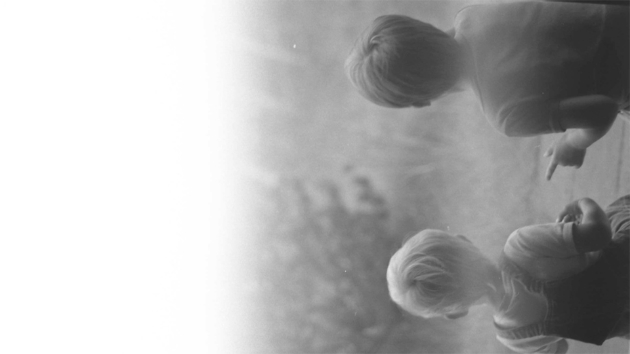
TIME GOES BY LIKE A ROARING LION - Philipp Hartmann
An average German male who was born in the 70s, lives up to be 76 1/2 years. Philipp Hartmann started filming in 2010. Then 38 1/4, he was exactly at the half point of his life. Suffering from chronophobia - fear of passing of time, he made this movie, clocking at 76 minutes, one minute counting as one year of his life. At the half point of the movie, he hurriedly catches up to "now" in a very inventive fashion.
This philosophical visual quandary isn't as dry as it sounds. It's warm, funny, and thought provoking. The still photos of Hartmann's childhood in the beginning, all only half exposed, are the compilation of the beginning of each film rolls, signifying the images just before his father captured that moment. He visits scientists at the site of atomic clock in Braunschweig. Apparently, because the earth is spinning slower at times, the clock needs to be adjusted a second every 18 months. The scientist futzes around with the switches and says, "Uh oh, I don't think it goes back..." Hartmann travels to the world's largest salt desert in Bolivia and contemplates the absence of time. He sets up situations with actors, narrating scenarios dealing with time. He asks one of his subjects/friends, who is a compulsive gambler about how he feels about ruining relations, his future. The friend replies that as time passes faster it hurts a little less. We watch Hartmann's shadow, sitting on a ski lift rolling over the green hills for the last 3-4 minutes of the movie. Contemplative and lyrical, Hartmann's inquiry is sincere and heartfelt rather than clever.

THE ANABASIS OF MAY AND FUSAKO SHIGENOBU, MASAO ADACHI AND 27 YEARS WITHOUT IMAGES - Eric Baudlaire
Paris based visual artist Eric Baudlaire films modern day Lebanon in super 8 at the request of Adachi Masao, a former United Red Army (later Japanese Red Army) member and guerrilla filmmaker. The film juxtaposes the footage of Lebanon and Japan. It is narrated by Adachi and Shigenobu May, a daughter of JRA leader Fusako and a Palestinian guerrilla fighter. Both Adachi and May spent 27 years in hiding in Lebanon, then extradited to Japan in 2001. Their lives are filled with fascinating stories.
Adachi, along with Wakamatsu Koji and Oshima Nagisa, plays a pivotal role in Japanese New Wave. But politically more extreme and hands on, Adachi chose a path that led him to devote in Palestine's cause for statehood, lived with guerrilla fighters in Lebanon refuge camps. May, who was born in Lebanon, never had a national or cultural identity until she was a teen, narrates her fascinating story in uninflected English. Their shared stories glide over the city and natural landscapes, film clips and news reels, accompanying the narrative. It's an interesting experiment: borrowing images, not to explicitly match them with someone's memories but to help us to imagine their experience. It's a fascinating trip.
The series also plays The Makes, Baudlaire's adaptation of Michelangelo Antonioni's notes on unmade films and The Ugly One, a sort of a sequel to Anabasis.
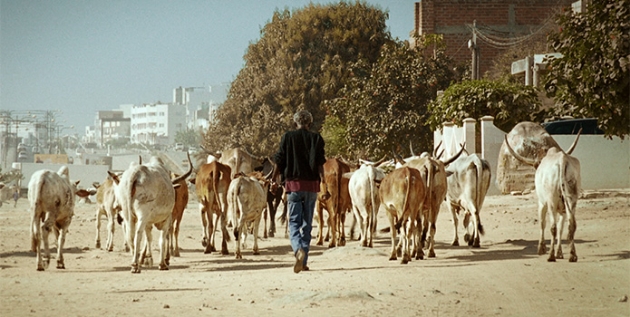
A THOUSAND SUNS - Mati Diop
Mati Diop, the alluring actress in Clare Denis's 35 rhums directs A Thousand Suns, a dreamy documentary fantasy that encompasses Senegal's past, present and perhaps future simultaneously. Taking cues from her famous Senegalese director uncle (Djibril Diop Mambéty)'s seminal African avant-garde film Touki Bouki, she incorporates the real actor Magaye Liang of that film, now an old man, still living in Dakar, herding cattles, into a fiction and vice versa. New and old collide and co-exist, as Liang watches Touki Bouki on the screen in an outdoor screening projected digitally. He says proudly that the dashing young man on the screen is indeed him. The street kids laugh at him. In that seminal film, Mory (Magaye Liang) stays behind while her lover Anta (Mareme Niang) sails to France. It reflects what happened in real life some 40 years ago, sort of.
Magaye tracks down Anta, now supposedly living in America. It turns out she lives in Alaska and works as a security guard on an oil rig, or so she tells him. The following snowy scene is jaw-droppingly sensual. The film is filled with colors, layers upon layers of hidden stories and rapturous images. I can't wait to see Diop's other work.
The series also plays Diop's Atlantiques which tells the story of a young boy’s tragic migratory voyage over the Moroccan border.
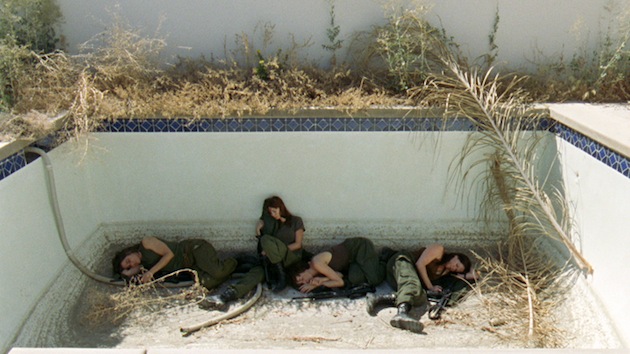
BLACK MOON - Amie Siegel *Part of Amie Siegel: Recent Works
The first thing I thought upon seeing the title of Amie Siegel's short form work was Louis Malle's feature film of the same name. Malle's film starts off with a literal war of the sexes: men and women, garbed in Army Green, guns-a-blazing. I was then rather struck by the first image in Siegel's Black Moon: a small, wary troop of female soldiers, guns drawn, trudge down a desert road. While Malle quickly abandons the idea for more or less a fairy tale, Siegel holds onto the potently bloody imagery, transplanting it to actual abandoned housing developments in Western America. Indeed I can't think of a more multi-faced image than that of the soldiers clearing a block of half-finished houses; the entire scene feeling as if it should be somewhere overseas, and in smoking ruins. But it is not.
Equally a chilling post-apocalyptic piece that leans on genre, and a stark, somber document of our inherent material obsessions, myopic notions of beauty and social statuses, Black Moon ends with a surreal dissonance that is all the more intriguing and unsettling than where we even began. And all the while the dormant houses sit and watch like ghosts, knowing they will never become homes. Will never be filled with life. -- Ben Umstead

WINTER - Amie Siegel *Part of Amie Siegel: Recent Works
Siegel's next work takes place over a New Zealand winter, and as one is soon to surmise, sometime after a nuclear winter. Beautifully shot on Super 16 the piece is a meditative study on isolation, nature and utopia (or perhaps cult). The cinephile and TV fan in me wants to describe this as Andrei Tarkovsky's Lost. One of the piece's most striking images is of a small child painting an entire globe black, except for the small bright splotch that is New Zealand. The moment is striking because it is not in the least dreadful or terrifying.
As it goes the mostly young and white glad subjects of Siegel's piece are not so much as waiting for oblivion as they are living in oblivion. And so what to do with such time and space... why remain curious, of course.
It is interesting to note that the full gallery exhibition version of Winter was designed to be accompanied by live narration, overdubbing, music making and mixing that would change with each successive screening. -- Ben Umstead
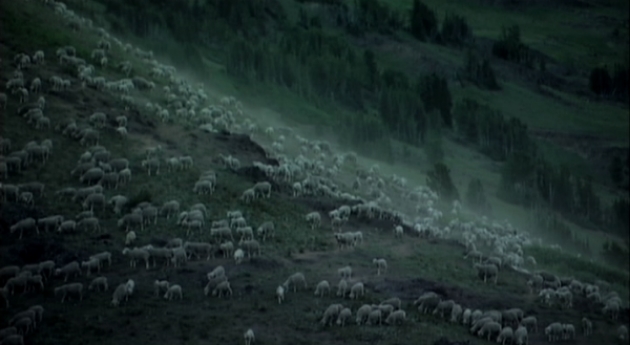
SWEETGRASS - no director credited *Part of Focus on The Sensory Ethnography Lab
As far as observational documentaries go, Sweetgrass hits the right note for me in every way- it works as an anthropological study of sheepherders (cowboys) in their most natural state, works as a spectacular nature documentary with unbelievably beautiful surroundings (Montana and part of Wyoming in various seasons) and works as a hypnotic/visceral art film with colors, movement and immediacy. I've seen this kind of work before- in Louis Malle and Robert Gardener (whose film, Forest of Bliss is considered the godfather of Havard's Sensory Ethnography Lab projects and plays in the series) India documentaries, Peter Bo Rappmund's Psychohydrography, James Benning's nature pieces etc.
Conceived and executed by Lucien Castaing-Taylor (Leviathan) and Illisa Barbash, the film is a marvelous achievement. The team seems to have found the perfect balance before it tipping over to become a gallery installation or worse, Baraka or Samsara which I consider nature porn. Castaing-Taylor possesses a keen, cinematic visual sense that is rare for this kind of filmmaking. Sweetgrass is an immensely watchable and engaging piece of work.

FOREIGN PARTS - Verena Paravel, JP Sniadecki *Part of Focus on The Sensory Ethnography Lab
Shot in 2008-2009 in an industrial neighborhood of Willets Point, Queens by Verena Paravel (Leviathan) and JP Sniadecki (People's Park) of the Havard's Sensory Ethnography Lab, Foreign Parts presents a rare glimpse into the lives of its inhabitants. Willets Point, in the shadows of 7 Train Line, Citi Field (Mets Baseball Stadium) and the constant planes flying overhead (La Guadia Airport only a stone's throw away) is where cars go die, being gutted and mutilated for their parts by various auto related shops. Without sewage systems and sidewalks, and most of the work force being immigrant workers, you'd think you are in Mexico or some other less developed country.
Paravel and Sniadecki just follow the residents around as they go about their daily business. There is Joe Ardizzone, a white haired, vocal resident who's been fighting for the city's redevelopment plan, there is Julia, a sweet natured, tiny old lady, and there are Luis and Sara, a couple who live in an abandoned car. They all talk candidly about their lives. The combination of these people's lives and their otherworldly surroundings - mountains of auto parts, unpaved dirt roads, gigantic water puddles, roaming wild feral animals, sonic plane engine and car noise, make Foreign Parts a fascinating concoction.

Do you feel this content is inappropriate or infringes upon your rights?
Click here to report it, or see our
DMCA policy.


































